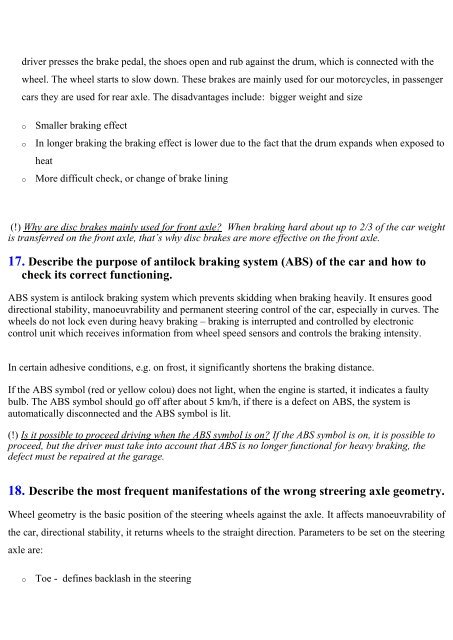Create successful ePaper yourself
Turn your PDF publications into a flip-book with our unique Google optimized e-Paper software.
driver presses <strong>the</strong> brake pedal, <strong>the</strong> shoes open <strong>and</strong> rub against <strong>the</strong> drum, which is connected with <strong>the</strong><br />
wheel. The wheel starts <strong>to</strong> slow down. These brakes are mainly used for our mo<strong>to</strong>rcycles, in passenger<br />
<strong>car</strong>s <strong>the</strong>y are used for rear axle. The disadvantages include: bigger weight <strong>and</strong> size<br />
o<br />
o<br />
o<br />
Smaller braking effect<br />
In longer braking <strong>the</strong> braking effect is lower due <strong>to</strong> <strong>the</strong> fact that <strong>the</strong> drum exp<strong>and</strong>s when exposed <strong>to</strong><br />
heat<br />
More difficult check, or change of brake lining<br />
(!) Why are disc brakes mainly used for front axle? When braking hard about up <strong>to</strong> 2/3 of <strong>the</strong> <strong>car</strong> weight<br />
is transferred on <strong>the</strong> front axle, that´s why disc brakes are more effective on <strong>the</strong> front axle.<br />
17. Describe <strong>the</strong> purpose of antilock braking system (ABS) of <strong>the</strong> <strong>car</strong> <strong>and</strong> how <strong>to</strong><br />
check its correct functioning.<br />
ABS system is antilock braking system which prevents skidding when braking heavily. It ensures good<br />
directional stability, manoeuvrability <strong>and</strong> permanent steering <strong>control</strong> of <strong>the</strong> <strong>car</strong>, especially in curves. The<br />
wheels do not lock even during heavy braking – braking is interrupted <strong>and</strong> <strong>control</strong>led by electronic<br />
<strong>control</strong> unit which receives information from wheel speed sensors <strong>and</strong> <strong>control</strong>s <strong>the</strong> braking intensity.<br />
In certain adhesive conditions, e.g. on frost, it significantly shortens <strong>the</strong> braking distance.<br />
If <strong>the</strong> ABS symbol (red or yellow colou) does not light, when <strong>the</strong> engine is started, it indicates a faulty<br />
bulb. The ABS symbol should go off after about 5 km/h, if <strong>the</strong>re is a defect on ABS, <strong>the</strong> system is<br />
au<strong>to</strong>matically disconnected <strong>and</strong> <strong>the</strong> ABS symbol is lit.<br />
(!) Is it possible <strong>to</strong> proceed driving when <strong>the</strong> ABS symbol is on? If <strong>the</strong> ABS symbol is on, it is possible <strong>to</strong><br />
proceed, but <strong>the</strong> driver must take in<strong>to</strong> account that ABS is no longer functional for heavy braking, <strong>the</strong><br />
defect must be repaired at <strong>the</strong> garage.<br />
18. Describe <strong>the</strong> most frequent manifestations of <strong>the</strong> wrong streering axle geometry.<br />
Wheel geometry is <strong>the</strong> basic position of <strong>the</strong> steering wheels against <strong>the</strong> axle. It affects manoeuvrability of<br />
<strong>the</strong> <strong>car</strong>, directional stability, it returns wheels <strong>to</strong> <strong>the</strong> straight direction. Parameters <strong>to</strong> be set on <strong>the</strong> steering<br />
axle are:<br />
o<br />
Toe - defines backlash in <strong>the</strong> steering




